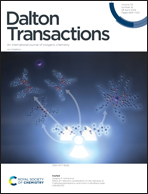New type of tin(iv) complex based turn-on fluorescent chemosensor for fluoride ion recognition: elucidating the effect of molecular structure on sensing property†
Abstract
A novel type of chemosensor based on tin(IV) complexes incorporating hydroxyquinoline derivatives has been designed and investigated for selectively detecting fluoride ions. Sn(meq)2Cl2 (meq = 2-methyl-8-quinolinol) (complex 1) exhibits a significant enhancement in luminescence upon the introduction of fluoride ions. This enhancement greatly surpasses that observed with Snq2Cl2 and Sn(dmqo)2Cl2 (q = 8-hydroxyquinnoline; dmqo = 5,7-dimethyl-8-quinolinol). Furthermore, complex 1 displays excellent sensitivity and selectivity for fluoride detection in comparison to halides and other anions. As a result, complex 1 serves as an outstanding turn-on fluorescent chemosensor, effectively sensing fluoride ions. The Benesi–Hilderbrand method and Job's plot confirmed that complex 1 associates with F− in a 1 : 2 binding stoichiometry. Also, complex 1 exhibited a large binding constant (pKb = 10.4 M−2) and a low detection limit (100 nM). To gain a deeper insight into the photophysical properties and the underlying mechanism governing the formation of the tin(IV) fluoride complex via halide exchange, we successfully synthesized partially fluorinated Sn(meq)2F0.67Cl1.33 (2) and fully fluorinated Sn(meq)2F2 (3), all of which were characterized through computational studies, thereby elucidating their photophysical properties. DFT studies reveal that converting Sn(meq)2Cl2 to Sn(meq)2F2, an endergonic process, leads to greater stability due to reducing steric hindrance about the metal center. Furthermore, the fluorinated complex significantly increases dipole moment, resulting in high affinity toward the F− ion.



 Please wait while we load your content...
Please wait while we load your content...